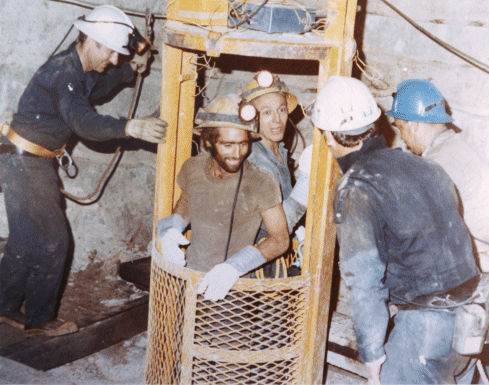26.F Shafts.
26.F.01 All wells or shafts over 5 ft (1.5 m) in depth that employees must enter must be supported by lagging, piling, or casing of sufficient strength to withstand shifting of the surrounding earth.
- The full depth of the shaft must be supported by casing or bracing except where the shaft penetrates into solid rock having characteristics that will not change because of exposure as determined by a CP or a Qualified Geotechnical Engineer.
- (1) Where the shaft passes through earth into solid rock or through solid rock into earth and where there is potential for shear, the casing or bracing must extend at least 5 ft (1.5 m) into the solid rock.
- (2) When the shaft terminates in solid rock, the casing of bracing must extend to the end of the shaft or 5 ft (1.5 m) into the solid rock, whichever is less.
- The casing or bracing must extend 42 in +/- 3 in (106.6 cm +/- 7.6 cm) above ground level, except that the minimum casing height may be reduced to 12 in (30.4 cm) provided that a standard railing is installed, that the ground adjacent to the top of the shaft is sloping away from the shaft collar to prevent entry of liquids, and that effective barriers are used to prevent mobile equipment operating near the shaft from jumping over the 12 in (30.4 cm) barrier.
26.F.02 After blasting operations in shafts, a competent person must inspect the walls, ladders, timbers, blocking, and wedges to determine if they have loosened. Where found unsafe, corrections must be made before shift operations are started.
26.F.03 No employee must be permitted to enter an unsupported auger-type excavation in unstable material for any purpose. In such cases, necessary clean-out must be accomplished without entry.
26.F.04 There must be two safe means of access in shafts at all times: this may include the ladder and hoist.
26.G Hoisting.
Hoistways may be used to hoist materials or personnel, but not both simultaneously.
26.G.01 A warning light suitably located to warn employees at the shaft bottom and subsurface shaft entrances must flash whenever a load is being moved in the shaft, except in fully enclosed hoistways.
26.G.02 Whenever a hoistway is not fully enclosed and employees are at the shaft bottom, conveyances or equipment must be stopped at least 15 ft (4.6 m) above the bottom of the shaft and held there until the signalman at the bottom of the shaft directs the operator to continue lowering the load; except that the load may be lowered without stopping if the load or conveyance is within full view of a bottom signalman who is in constant voice communication with the operator.
26.G.03 Before maintenance, repairs, or other work is commenced in a shaft served by a cage, skip, or bucket, the operator and other employees must be informed and given suitable safety precautions. A sign warning that work is being performed in the shaft must be installed at the shaft collar, at the operator's station, and at each underground landing.
26.G.04 Any connection between the hoisting rope and the cage or skip must be compatible with the type of wire rope used for hoisting.
26.G.05 Spin-type connections, where used, must be maintained in a clean condition and protected from foreign matter that could affect their operation.
26.G.06 Cage, skip, and load connections to the hoist rope must be made so that the force of the hoist pull, vibration, misalignment, release of lift force, or impact will not disengage the connection. Moused or latched open-throat hooks do not meet this requirement.
26.G.07 When using wire rope wedge sockets, means must be provided to prevent wedge escapement and to ensure that the wedge is properly seated.
Knowledge Check Choose the best answer for the question.
26-11. When a hoistway is not fully enclosed and employees are at the shaft bottom, when must conveyances or equipment be stopped and held there until the signalman at the bottom of the shaft directs the operator to continue lowering the load?
You forgot to answer the question!

